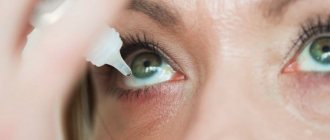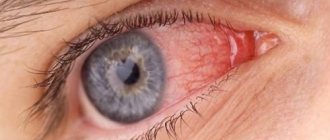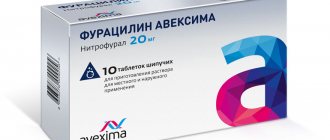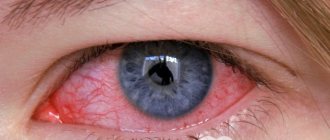Permitted and prohibited drops during breastfeeding: what mothers should know
Eye diseases require immediate treatment, usually local. And lactation makes you wary of taking any medications. After all, some of them can pass through milk to the baby. Therefore, eye drops should be used with caution when breastfeeding. Among them there are some that should not be used at all during this period.
Common eye drops: do's and don'ts
It is necessary to get rid of an eye disease like any other. An infection that has captured the visual organ is caused by microorganisms that migrate easily. That is, the disease can spread and become even more threatening and global. Then it can be passed on to the child.
The instructions for many eye drops contain information about the undesirability of use during lactation, for some there is a direct ban on it. In some cases it is recommended to use with caution.
But nursing mothers are still worried that eye drops during lactation will harm the baby, even when the doctor prescribes them. In order not to worry in vain, it is worth knowing about the entire range of such drugs.
"Vigamox"
The drug "Vigamox" is prescribed for eye infections, as it belongs to the group of fluoroquinolone antibiotics. Therefore, it effectively and in a short time copes with different types of bacteria. Vigamox is dripped 3-4 times a day, and it begins to act within 15 minutes after contact with the eye.
When prescribing it, nursing mothers are confused by the fact that the drug enters the blood in small quantities and can also leak into breast milk. However, you should not refuse to use the product if it is recommended by your doctor. This is a strong antibiotic. And when the ophthalmologist prescribes it, it follows that other means are useless.
In other cases, Vigamox should be replaced with safer drops. Moreover, you cannot use it yourself.
"Tobrex"
Tobrex eye drops
Another modern and effective remedy is Tobrex. It is an antibiotic amine glycoside, that is, a substance used in the treatment of many bacterial infections. Therefore, using it randomly during lactation is risky. The main component of the product can cause allergies in the mother, and if it gets into the milk, also in the baby.
On the other hand, Tobrex is an eye drop for breastfeeding, prescribed primarily for bacterial infection. They are very effective and are used for no longer than 7 days. And most importantly, they are also prescribed for conjunctivitis in children under 1 year of age. This alone is sufficient evidence of the safety of Tobrex, if, of course, you use them in accordance with the recommendations of a specialist.
"Albucid"
Albucid drops are one of the proven remedies used for bacterial eye infections. The active ingredient of the drug belongs to the group of sulfonamides. This type of antibiotics is acceptable during lactation.
Therefore, in case of eye problems, Albucid may be prescribed before other drugs. It copes well with conjunctivitis, blepharitis, and cures the consequences of corneal injuries. The drug is prescribed even to newborns, if indicated.
This is one of the safest remedies for lactation.
However, you should not use even Albucid for a long time (for a course) without a doctor’s prescription; eye drops during breastfeeding can also cause an allergic reaction in mother and baby.
"Levomycetin"
Levomycetin eye drops have an effect on gram-positive and gram-negative microorganisms. Their wide spectrum of action allows them to be used where weaker antibiotics are powerless. But this strong effect does not make it possible to use them for women who are breastfeeding, without transferring the child to artificial nutrition.
The drug passes into milk, so it can enter the baby’s body. This is especially undesirable if he is less than 4 months old. Use of the product by the mother can lead to indigestion in the child and an allergic reaction.
For these reasons, you should not use chloramphenicol on your own; eye drops during breastfeeding are prescribed by specialists only in extreme cases. And if you have to be treated with them, you should temporarily switch the baby to formula.
"Vizin"
Visin eye drops
Sometimes moisturizing and vasoconstrictor drops are enough to restore health and a feeling of comfort to the eyes. Vizin is one of these products. It relieves swelling, reduces lacrimation and irritation of the eye mucosa, and copes with catarrhal conjunctivitis.
This is a more harmless remedy than the previously considered antibiotics. It can be used during lactation as prescribed by an ophthalmologist without interrupting feeding. The only undesirable reaction that a baby may experience from using Visine is an allergy.
To ensure that the effect of using Visin is limited to eliminating problems with the mother’s eyes, it is dripped no more than 3 times a day. And after 4 days of use, the drug relieves negative symptoms. If there is no result after the first 2 days, treatment with Visin should be stopped and once again contact a specialist for another prescription.
"Tsipromed"
Antibacterial drops "Tsipromed" belong to the group of fluoroquinolones. This type of substance is extremely undesirable for newborns. The entry of fluoroquinolones into the baby’s body is fraught with many negative consequences for him.
It has been established that Tsipromed eye drops leak into breast milk in minimal quantities if a woman uses them to treat an infectious-inflammatory disease.
Therefore, despite their effectiveness, they are rarely prescribed during lactation, only when absolutely necessary. And if a woman uses Tsipromed, eye drops during breastfeeding force her to temporarily give her baby artificial formula.
During treatment and for several days after its completion, milk should be expressed and discarded.
Others
The therapy of eye diseases is not limited to the listed drugs. There are products that can be used safely during lactation:
- "Ophthalmoferon" is used in the treatment of various origins of conjunctivitis, keratitis, as well as dry eye syndrome. It is also indicated for swelling of the mucous membrane caused by allergies, to prevent relapses of these diseases. "Ophthalmoferon" cannot be compared in effectiveness with antibiotics. But it can be used during lactation without the risk of harming the baby. Despite the presence of diphenhydramine, it is safe. After all, Oftalmoferon does not pass into breast milk. Of course, do not forget about the correct dosage of the product.
- "Aktipol" is an antiviral drug for the eyes that stimulates the production of its own immune cells. It relieves swelling well and eliminates conjunctivitis, restores damaged cornea. The active ingredient of the drug does not penetrate into the blood or breast milk. Therefore, when asked what kind of eye drops can be used during lactation, they call “Actipol”.
- "Vitabact" has broad capabilities to combat bacteria leading to conjunctivitis, keratitis, and trachoma. One of its features is the lack of influence on the composition of breast milk. Therefore, Vitabact can be used during lactation without fear for the child.
Watch the video on how to properly instill eye drops:
Is it necessary to interrupt breastfeeding?
Even if a woman intends to use antibacterial eye drops as prescribed by a doctor, she should not immediately interrupt breastfeeding. Without reservation, this should be done only if several factors coincide:
- the child is less than 3 months old (the infant’s body is still very vulnerable and can react unpredictably to the mother’s use of medications);
- the instructions for the drug clearly prohibit its use during lactation;
- The doctor categorically insists on temporarily transferring the child to artificial formula feeding.
The absence of these circumstances allows the combination of treatment with eye drops and hepatitis B. To prevent drugs from becoming a source of problems for the baby’s health, there are rules for use:
- You should not prescribe treatment yourself. Almost all products have safer analogues, but only a specialist can tell you which one to choose.
- If you need help urgently, but it is not possible to see a doctor immediately, it is permissible to use any drops suitable for treating the problem several times. This will not cause much damage to the baby. But later you should still consult an ophthalmologist.
- When visiting a doctor, be sure to mention that there is an infant in the house. This will help you choose the best option for treating your mother’s eyes.
- Use drops according to instructions. You should not exceed the dosage if you want to recover faster. For the treatment to be effective, you need to be able to apply eye drops correctly. You should pull back the lower eyelid and inject the drug without touching the tip of the bottle to the mucous membrane or skin. Then you need to blink several times so that the product is distributed over the surface of the eyes.
- It is imperative to monitor the child’s reaction. If diarrhea occurs or skin rashes appear, the baby becomes restless, it is possible that the influence of the tiny amount of medicine that has penetrated into the milk is to blame.
We recommend reading the article about drops for a runny nose during lactation. From it you will learn about the treatment of a runny nose in a nursing mother, the use of drugs with a vasoconstrictor effect, the possibility of using antibiotics and immunomodulators.
The desire to breastfeed your son or daughter is commendable. But it should not contradict taking care of your own health. Otherwise, the baby remains at risk of getting sick. And with a reasonable approach, you can combine the treatment of the mother and the comfortable existence of the child.
Source: https://GrudInfo.ru/glaznye-kapli-pri-grudnom-vskarmlivanii/
Tips on how to treat conjunctivitis while breastfeeding, so as not to harm the baby and yourself
Conjunctivitis is an ophthalmological disease, inflammation of the mucous membrane of the eye. The main reason for the appearance of the disease is the entry of different types of bacteria, viruses and allergens into the organs of vision.
The disease is not considered too serious or dangerous to health, but if it occurs in a woman during breastfeeding, transmission of the infection from mother to child is possible.
In addition, many drugs used in the treatment of conjunctivitis are prohibited during lactation, so the disease must be treated strictly under the supervision of an ophthalmologist.
ontakte
Odnoklassniki
When breastfeeding, the signs of conjunctivitis are not much different from those symptoms of the disease that occur in ordinary women.
Viral conjunctivitis is accompanied by:
- translucent or purulent discharge;
- redness of the eyes;
- alternating eye damage.
Bacterial conjunctivitis is characterized by:
- purulent discharge from the eyes;
- malaise;
- weakness;
- headache;
- enlarged lymph nodes;
- blurred vision;
- swelling of the eyelids;
- profuse lacrimation;
- redness of the eyes.
Allergic conjunctivitis manifests itself:
- simultaneous eye damage;
- severe itching;
- lacrimation.
Important! If there are severe manifestations of an infectious disease in the mother, it is necessary to protect the baby from infection.
Symptoms of conjunctivitis can easily be confused with manifestations of acute respiratory infections, but it is still possible to distinguish one disease from another. Signs characteristic only of ophthalmic diseases are decreased quality of vision and purulent discharge from the corners of the eyes.
Treatment of conjunctivitis during breastfeeding
During the feeding period, there are many contraindications to the use of medications.
It is not recommended to resort to self-medication , as it can negatively affect both the quantity and quality of milk and the health of the child.
For viral conjunctivitis, after diagnosis, the nursing mother is prescribed antiviral drops or ointments. The most common and safe drugs are Actipol and Oftalmoferon .
Important! with great caution during lactation . To ensure that the active substance does not harm the child’s health, the medicine must be diluted with water.
Bacterial conjunctivitis must be treated with antibacterial or anti-inflammatory drugs. Medicines are usually available in the form of ointments or eye drops that are applied directly to the mucous membrane of the affected eye. Most often, this form of the disease requires the use of local antibiotics ( Vitabact, Levomycetin, Tobrex ).
Photo 1. Vitabact eye drops 0.05%, 10 ml from.
For chlamydial conjunctivitis, both parents are treated. Drugs from the fluoroquinolone group are used ( Tsipromed, Vigamox ). The medications are quite aggressive, so they require temporary cessation of breastfeeding.
Treatment of allergic conjunctivitis begins with eliminating the allergen, after which antihistamines are prescribed. Fenistil is available in the form of drops or ointments and is applied to the mucous membrane of the eyes. Antihistamines also tend to pass into breast milk, so their use requires consultation with a doctor.
Attention! With properly selected therapy and the absence of complications, conjunctivitis resolves within 7–14 days .
How and what to treat when turning to traditional medicine
To prepare a chamomile decoction you will need 2 tablespoons of the herb and 250 ml of hot water. Bring the water to a boil, add the herb to it and keep it on low heat for no more than 10 minutes . Then the broth needs to be cooled and strained. The folk remedy is used every 2 hours to wash the eyes.
Photo 2. The boiling chamomile infusion is cooled a little, filtered, then it needs to be rubbed onto the eyes several times a day.
To prepare tea leaves for eye treatment, you need to use tea without additives. Brew one tablespoon of tea with 200 ml of water and leave for about 20 minutes .
Important! Traditional medicine should be used only as an auxiliary part of the main drug therapy.
Then the tea leaves are cooled, filtered and used to wash the eyes.
The video explains by what symptoms conjunctivitis can be recognized and discusses some traditional methods of treatment.
Proper selection of medications will help you quickly get rid of the disease and prevent possible complications . When using non-aggressive drugs, it is possible not to wean the child from the breast.
Rate this article:
Be first!
Average rating: 0 out of 5. Rated by: 0 readers.
Share with your friends!
ontakte
Odnoklassniki
Source: https://linza.guru/konyunktivit/lechenie/dlya-kormyashchih-mam/
Bacterial conjunctivitis
During breastfeeding, the mother transfers a lot of nutrients to the baby; also during pregnancy and in the postpartum period, hormonal levels change, which is accompanied by a decrease in immunity. A woman becomes more susceptible to any infection, so conjunctivitis during breastfeeding is not uncommon. The disease develops due to infection entering the eye sac through dirty hands, and can also be a complication of viral inflammation.
A young mother should pay special attention to the cleanliness of her hands so as not to infect her baby.
Symptoms
The main symptoms of the disease are approximately the same as for viral conjunctivitis - redness, dryness, burning of the eyes, swelling of the eyelids. However, some symptoms are typical specifically for bacterial inflammation:
- Both eyes are affected simultaneously;
- the discharge is purulent in nature;
- pronounced hyperemia of the eyeballs;
- the eyelids are very swollen, they are covered with crusts;
- in the morning it is difficult to open the eyelids due to the abundant secretion;
- the woman’s general well-being is disrupted.
Separately, we should consider chlamydial conjunctivitis, which is caused by small bacteria that parasitize inside cells. It develops against the background of a woman already having a chlamydial infection. The provocateur of the disease is any immunodeficiency state - hypothermia, colds, unbalanced diet, stress.
The provocateur of conjunctivitis is any immunodeficiency condition.
The symptoms are as follows:
- Sluggish flow;
- damage to first one and then both eyes;
- discharge of a mucopurulent nature, scanty;
- enlargement of nearby lymph nodes;
- inflammation of the auditory tube - eustacheitis, which is characterized by decreased hearing and ear pain.
It is possible to cure chlamydial conjunctivitis with the help of antibacterial agents, which are selected depending on the sensitivity of the microbe to a particular medication.
Diagnosis of conjunctivitis
Before prescribing treatment, it is necessary to establish the cause of the inflammation. To do this, the doctor conducts a visual examination and assesses the degree of damage to the eye using a slit lamp. A cytological and bacterioscopic examination of the exudate is prescribed. In case of bacterial infection, it is necessary to determine the sensitivity of microbes to antibiotics.
Treatment of bacterial conjunctivitis
To combat pathogenic microbes, eye drops and ointments containing antibiotics are used. Several times a day, the eyes should be cleaned of accumulated crusts and pus using a cotton pad using antiseptic solutions (furatsilin or potassium permanganate). After thorough washing of the eyelids and conjunctival sac, irrigation with antibacterial drugs is carried out. At night, eye ointment (tetracycline or erythromycin) is applied to the lower eyelid.
Many topical medications are absorbed and enter the baby's body with milk, so they are used to a limited extent during lactation. A doctor must prescribe treatment.











